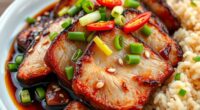During Eid al-Fitr, Indonesians celebrate with a variety of traditional dishes that symbolize unity and gratitude. You’ll find rice cakes like ketupat served with flavorful meats such as opor ayam or beef rendang, along with sweet treats like dodol and cookies like nastar. Sharing these foods with family, friends, and neighbors strengthens bonds and keeps cultural traditions alive. Continue exploring to learn more about the rich culinary customs that make Lebaran special.
Key Takeaways
- Indonesians celebrate Eid with traditional dishes like ketupat, opor ayam, and beef rendang, symbolizing unity and gratitude.
- Preparing and sharing special recipes fosters community bonds and preserves cultural heritage during Lebaran.
- Food acts as a language of love, with families and neighbors exchanging dishes in lively gatherings.
- Traditional ingredients and tools are used to maintain authenticity and craftsmanship in festive recipes.
- Collective cooking and sharing meals reinforce social ties and celebrate togetherness during Eid festivities.

Eid al-Fitr, known locally as Lebaran, is a time when Indonesians come together to celebrate with an abundance of delicious food. It’s a moment filled with joy, gratitude, and shared traditions. You’ll notice that food plays a central role in these festivities, serving as a symbol of unity and generosity. During Lebaran, families and friends gather in communal settings, often at homes or mosques, to enjoy traditional recipes passed down through generations. These recipes aren’t just about taste; they carry cultural significance and a sense of continuity. You’ll find that preparing these dishes is often a collective effort, bringing everyone closer as they work together in the kitchen, sharing stories and laughter. The act of cooking and sharing food becomes a meaningful ritual that strengthens bonds and honors heritage.
The traditional recipes served during Lebaran are as diverse as Indonesia itself. You might indulge in ketupat, rice cakes packed into woven palm leaf pouches, which are often served with savory opor ayam (chicken cooked in coconut milk) or beef rendang. These dishes are rich in flavor and symbolize prosperity and abundance. Another popular dish is ketupat sayur, a vegetable stew with rice cakes, offering a comforting taste of home. For those with a sweet tooth, there’s dodol, a sticky, sweet toffee made from coconut milk, sugar, and rice flour, along with various cookies like nastar and kuih bangkit. These treats are meticulously prepared, often days before the celebration, highlighting the importance of tradition and patience. Additionally, the preparation of these dishes often involves dedicated kitchen tools, which help ensure the authenticity and quality of the recipes.
During Lebaran, communal gatherings revolve around sharing these dishes with loved ones. It’s common to visit relatives and neighbors, exchanging plates of food as a gesture of goodwill. These gatherings are lively, filled with conversations, laughter, and the aroma of freshly cooked meals. The act of sharing traditional recipes fosters a sense of community, reinforcing social bonds and cultural pride. It’s not just about feeding the body but nourishing relationships and preserving ancestral customs. As you participate in these festivities, you’ll realize that the true essence of Lebaran lies in the collective effort, the rich flavors, and the warmth of coming together. Food becomes a language of love and gratitude, making Eid a truly unforgettable celebration of unity through shared traditions.
Frequently Asked Questions
How Do Regional Differences Influence Eid Food Traditions in Indonesia?
You’ll notice that regional variations markedly shape Eid food traditions across Indonesia, influenced by local culinary influences. In Java, you might enjoy rendang and ketupat, while in Sumatra, spicy dishes like gulai reign supreme. These regional differences reflect diverse ingredients and cooking styles, making each area’s celebration unique. By embracing these variations, you get a richer, more authentic experience of Indonesia’s vibrant Eid festivities.
What Are the Traditional Drinks Served During Eid Feasts?
During Eid feasts, you’ll enjoy traditional beverages like sweet bandrek and warm teh tarik, which add to the festive atmosphere. These drinks are popular for their comforting flavors and are often served to guests. You might also sip on es buah, a colorful fruit cocktail, or traditional herbal teas. These festive drinks help create a joyful, welcoming environment, making your Eid celebration even more special.
How Do Indonesian Families Prepare for Large Eid Gatherings?
You start by planning the menu for the Eid family preparations, ensuring you include traditional dishes and treats. You clean and decorate your home to create a welcoming atmosphere for the communal feast customs. You also buy or prepare special ingredients ahead of time and coordinate with family members to share cooking responsibilities. This teamwork and attention to detail help make the large Eid gatherings joyful and memorable for everyone.
Are There Any Specific Foods for Children During Eid Celebrations?
During Eid celebrations, you’ll find special festive snacks for kids like sweet candies, colorful jellies, and small traditional treats called kue kecil. These Eid children’s treats are designed to delight young ones and keep them engaged. You might also see playful snacks shaped into animals or festive symbols. These treats add joy to the celebration and make children feel included in the festive spirit, creating lasting memories for everyone.
How Has Modern Cuisine Affected Traditional Eid Dishes in Indonesia?
Modern cuisine has greatly influenced traditional Eid dishes in Indonesia. You’ll notice fusion cuisine blending local flavors with international styles, creating exciting new dishes. Street food vendors also play a role, offering quick, innovative options that complement classic favorites. This blend of old and new enriches your celebration, making Eid feasts more diverse and vibrant while still honoring cultural traditions. Embrace these changes to enjoy a dynamic and memorable holiday meal.
Conclusion
As you join Indonesians in their vibrant Eid feasts, you’ll realize that food isn’t just sustenance – it’s a bridge connecting generations, much like the timeless tales of the Arabian Nights. From savory ketupats to sweet dodol, every dish tells a story of tradition and togetherness. So, embrace the joy, share the feast, and remember, in this festive spirit, even a humble plate can become a treasure chest of memories.









